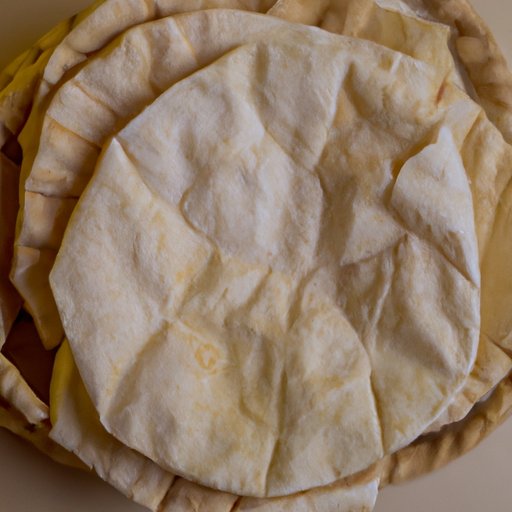Introduction
Pita bread is a type of flatbread that has become increasingly popular in recent years. It is made from simple ingredients like flour, water, yeast, and salt, and can be served with a variety of different toppings or fillings. But is pita bread healthy? In this article, we will explore the health benefits of pita bread, including its nutritional profile, how to incorporate it into a healthy diet, and common myths about its health benefits.

Exploring the Nutritional Benefits of Pita Bread
Pita bread is a good source of several essential nutrients, including carbohydrates, protein, vitamins, minerals, and dietary fiber. One serving (or one piece of pita bread) contains approximately 110 calories, 20 grams of carbohydrates, 4 grams of protein, 2 grams of dietary fiber, and 0.5 grams of fat. It also provides small amounts of calcium, iron, magnesium, and potassium.
The dietary fiber content of pita bread makes it a great choice for those looking to increase their fiber intake. According to the American Heart Association, “dietary fiber helps reduce cholesterol levels and may lower your risk of heart disease, stroke, obesity, and type 2 diabetes.” Furthermore, the combination of carbohydrates and protein in pita bread can help keep you feeling full and satisfied throughout the day.
An Overview of Pita Bread: Is it Healthy?
When it comes to deciding whether or not pita bread is healthy, it is important to consider the nutrition facts label. A look at the nutrition facts label for one piece of pita bread reveals that it contains 110 calories, 20 grams of carbohydrates, 4 grams of protein, 2 grams of dietary fiber, and 0.5 grams of fat.
When it comes to calories, pita bread is considered a low-calorie food. However, it is important to note that the calorie content can vary depending on the size and thickness of the pita bread. Additionally, if you are topping or filling the pita bread with high-calorie ingredients, such as cheese or hummus, the calorie content will increase.
In terms of its macronutrient profile, pita bread is mostly composed of carbohydrates, with a moderate amount of protein and a small amount of fat. This makes it an ideal choice for those looking to increase their carbohydrate intake without consuming large amounts of fat or calories.

How to Incorporate Pita Bread into a Healthy Diet
When it comes to incorporating pita bread into a healthy diet, it is important to remember that portion size matters. The American Heart Association recommends consuming no more than one piece of pita bread per meal. Additionally, it is important to be mindful of the toppings or fillings you choose, as these can add extra calories, fat, and sugar to your meal.
One creative way to use pita bread is by making individual pizzas. Simply top one piece of pita bread with your favorite sauce, vegetables, and cheese. You can also use pita bread to make homemade gyros or falafel wraps. Finally, pita bread can be used as a healthy alternative to crackers or chips when dipping into hummus or other dips.

The Pros and Cons of Eating Pita Bread
Like any food, pita bread has both advantages and disadvantages. On the plus side, pita bread is a good source of essential nutrients, including carbohydrates, protein, vitamins, minerals, and dietary fiber. Additionally, it is low in calories and fat, making it a great choice for those looking to lose weight or maintain a healthy weight. Finally, it is versatile and can be used in a variety of different recipes.
On the downside, some people may find that pita bread is difficult to digest due to its high gluten content. Additionally, the calorie content can vary based on the size and thickness of the pita bread, as well as the toppings or fillings that you choose. Finally, it is important to remember that eating too much pita bread can lead to weight gain, so it is important to practice moderation when incorporating it into your diet.
Common Myths About Pita Bread and its Health Benefits
There are several common misconceptions about pita bread and its health benefits. For example, some people believe that because pita bread is made from wheat flour, it is unhealthy. In fact, research shows that whole-grain wheat flour is a nutritious source of carbohydrates, protein, and dietary fiber. Another myth is that pita bread is high in sodium. While some brands of pita bread do contain added salt, most varieties contain less than 100 milligrams of sodium per serving, which is considered a low-sodium food.
Finally, some people believe that pita bread is high in sugar. However, most varieties of pita bread contain less than 1 gram of sugar per serving, which is considered a low-sugar food. It is important to read the nutrition facts label carefully to ensure that the pita bread you choose is low in sugar.
Conclusion
In conclusion, pita bread can be a healthy addition to your diet when eaten in moderation. It is a good source of essential nutrients, including carbohydrates, protein, vitamins, minerals, and dietary fiber. Additionally, it is low in calories and fat, making it a great choice for those looking to lose weight or maintain a healthy weight. Just remember to be mindful of the toppings or fillings you choose, as these can add extra calories, fat, and sugar to your meal.
Finally, it is important to be aware of the common myths surrounding the health benefits of pita bread. The truth is that pita bread is a nutritious source of carbohydrates, protein, and dietary fiber, and can be a healthy addition to your diet when eaten in moderation.
(Note: Is this article not meeting your expectations? Do you have knowledge or insights to share? Unlock new opportunities and expand your reach by joining our authors team. Click Registration to join us and share your expertise with our readers.)
